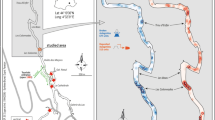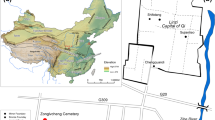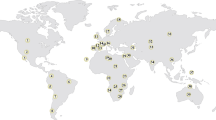Abstract
The Iron Age societies of the southeastern Iberian Peninsula, like their Greek and Etruscan counterparts, used stone sculptures to decorate their sanctuaries and cemeteries. Limestone was the raw material used. While abundant throughout the region, it was not always of sufficient quality to implement the iconographic projects at hand. This paper describes a study of Jutia monument (fourth to second centuries BCE), an architectural structure supporting a number of zoomorphic sculptures. Located at a distance from any major city of the time, the sculptor’s workshop had to select the best materials in the surrounds. The present study aims to establish the origin of the limestone used and ascertain how decisions were made and collective work invested to build this monument. A geological study of the possible areas of origin is supplemented with the petrological characterisation of the respective outcropped materials and the archaeological elements recovered. Colour parameters, ultrasound pulse velocity (UPV) and limestone hardness and geochemical composition, the latter using a handheld XRF instrument, are also determined. The findings reveal that the figures were sculpted from Upper Miocene calcarenite or sandy limestones quarried at around 3 km from the site. In contrast, other parts of the building were erected with bioclastic limestone from the immediate surrounds, at just 200 m from the monument.












Similar content being viewed by others
References
Aoki H, Matsukura Y (2007) A new technique for non-destructive field measurement of rock-surface strength: an application of the Equotip hardness tester to weathering studies. Earth Surf Process Landf 32(12):1759–1769. https://doi.org/10.1002/esp.1492
Belén Deamos M, Chapa Brunet T, Vázquez C, Fort R (2009) The first evidence of a Tartessian stone sculpture: a fragmentary cult image from Carmona (Seville, Spain), in: Leukos Lithos. Marbres et Autres Roches de la Méditerranée Antique: Études Interdisciplinaires. Actes ASMOSIA VIII. 8 th International Conference, (Aix-en-Provence12–18 juin 2006), Karthala, Paris, pp 243–254
Boardman J (1994) The diffusion of classical art in antiquity. London. 352 pages. ISBN 13: 9780500236963
Brennan ML, King EM, Shaw LC, Walling SL Jr (2013) Preliminary geochemical assessment of limestone resources. J Archaeol Sci 40(8):3178–3192
Carò F, Douglas JG (2013) Nature and provenance of the sandstone used for Bayon style sculptures produced during the reign of Jayavarman VII. J Archaeol Sci 40:723e734
Chapa T 2008–2009. Esculturas ibéricas de El Álamo-Jutia (Yeste-Nerpio, Albacete. In: Shattner T, Rovira Llorens S (Eds), Homenaje al Dr. Michael Blech. Boletín de la Asociación Española de Amigos de la Arqueología 45, Madrid, pp 79–92
CIE, Commision Internacionale de lÉclarage (2004) Colorimetry, 15, publication, 3rd edn. CIE, Wien
Criado Boado F (1997) Introduction. Combining the different dimensions of landscape. It’s a total landscape archaeology possible? In: Criado F, Parcero C (eds) Landscape, Archaeology, Heritage. TAPA 2. Universidad de Santiago de Compostela, Santiago de Compostela, pp 5–10
de Winter NJ, Sinnesael M, Makarona C, Vansteenberge S, Claeys P (2017) Trace element analyses of carbonates using portable and micro-X-ray fluorescence: performance and optimization of measurement parameters and strategies. J Anal At Spectrom 32(6):1211–1223. https://doi.org/10.1039/C6JA00361C
Gagnaison C, Montenat C, Barrier P, Rouillard P (2007) L’environnement du site ibérique de La Alcudia et les carrières antiques de la Dame d’Elche (Province d’Alicante, Espagne). ArcheoSci Revue d'archéométrie 31:59–78
Gener M, Romero D, González S, García J (2016) Estudio metalúrgico de las armas ibéricas halladas en el valle de Jutia (Nerpio-Yeste, Albacete). Trabajo, armamento, ritual y comunidades de montaña. Gladius 36:7–31. https://doi.org/10.3989/gladius.2016.0001
Gómez-Heras M, Fort R (2004) Location of quarries of non-traditional stony materials in the architecture of Madrid: the crypt of the Cathedral of Santa María la real de la Almudena. Mater Constr 54(274):33–49. https://doi.org/10.3989/mc.2004.v54.i274.231
González Reyero S (2013) Documentación y estudio del poblamiento ibérico en la cuenca alta del río Segura (Albacete), unpublished report. Junta de Castilla-la Mancha, Toledo
González Reyero S, Chapa Brunet T, Sánchez-Palencia FJ, García Cardiel J, (2016) Las comunidades iberas en paisajes de montaña. El caso de la Cuenca Alta del río Segura. En Blanca Gamo Parras y Rubí Sanz Gamo (coord): Actas de la I Reunión Científica de Albacete. Instituto de Estudios Albacetenses “Don Juan Manuel”. Excma. Diputación de Albacete. Albacete, pp 383-398
Guydader J, Denis A (1986) Propagation des ondes dans les roches anisotropes sous contrainte évaluation de la qualité des schistes ardoisiers. Bull Eng Geol 33:49–55
Hayes K (2013) Parameters in the use of pXRF for archaeological site prospection: acase study at the Reaume Fort site, Central Minnesota. J Archaeol Sci 40:3193e3211
Horden P, Purcell N (2000) The corrupting sea. A study of Mediterranean history. Wiley-Blackwell, Oxford 776 pages. ISBN: 978-0-631-21890-6
IGME (1979) Mapa Geológico de España 1:50.000. Yetas de Abajo (23–35). Ministerio de Industría y Energía. 68 pp. ISSN: 073–2096
León P (1998) La sculpture des Ibères. Collection Histoire Ancienne et Anthropologie. Harmattan, París. 109 pages. ISBN: 2-7384-7240-0
Ogburn D, Sillar B, Sierra JC (2013) Evaluating effects of chemical weathering and surface contamination on the in situ provenance analysis of building stones in the Cuzco region of Peru with portable XRF. J Archaeol Sci 40:1823e1837
Olmos R, Rouillard P (2002) Sculpture préromaine de la Péninsule Ibèrique. Documents d’Archéologie Méridionale 25:269-283
Quye-Sawyer J, Vandeginste V, Johnston KJ (2015) Application of handheld energy-dispersive X-ray fuorescence spectrometry to carbonate studies: opportunities and challenges. J Anal At Spectrom 30(7):1490–1499. https://doi.org/10.1039/C5JA00114E
Ruiz A, Molinos M (1993) Los iberos. Análisis arqueológico de un proceso histórico. Ed. Crítica. Barcelona. 336 pages. ISBN 9788474235661
Tilley C (1999) Metaphor and material culture. Blackwell, Oxford 320 pages
Tilley C (2004) The materiality of stone. Explorations in Landscape Phenomenology. Berg. Oxford, New York 264 pages
Tripati S, Mudholkar AV, Vora KH, Rao BR, Gaur AS, Sundaresh (2010) Geochemical and mineralogical analysis of stone anchors from west coast of India: provenance study using thin sections, XRF and SEM-EDS. J Archaeol Sci 37(8):1999–2009. https://doi.org/10.1016/j.jas.2010.03.005
Vavro M, Gajda J, Prĭkryl R, Siegl P (2015) Soapstone as a locally used and limited sculptural material in remote area of Northern Moravia (Czech Republic). Environ Earth Sci 73(8):4557–4571. https://doi.org/10.1007/s12665-014-3742-3
Viles H, Goudie A, Grab S (2011) The use of the Schmidt Hammer and Equotip for rock hardness assessment in geomorphology and heritage science: a comparative analysis. Earth Surf Process Landf 36(3):320–333. https://doi.org/10.1002/esp.2040
Williams M, Wilkinson I, Taylor J, Whitbread I, Stamp R, Boomer I, Yates E, Stocke C (2015) Microfossil-determined provenance of clay building materials at Burrough Hill Iron Age hill fort, Leicestershire, England. J Archaeol Sci 54:329e339
Acknowledgements
The authors wish to thank Albacete Museum, the Municipal Government of Nerpio and Yeste and the History Institute’s R&D laboratories (CCHS, Spanish National Research Council) for the support provided throughout this study.
Manuscript edited by Margaret Clark, professional translator and English language science editor.
Funding
This study was funded by the Spanish Ministry of the Economy and Competitiveness under projects HAR2012-35208 and HAR2015-67355-P; the Regional Government of Castile-La Mancha under project 15.0904; and the Regional Government of Madrid in the framework of the GEOMATERIALS-2CM [S2013/MIT-2914] programme. The senior author is a member of the ‘Applied Petrology for Heritage Conservation’ research team [ref. 921349]. The analyses were conducted at the Institute of Geoscience’s petrophysical laboratory.
Author information
Authors and Affiliations
Corresponding author
Rights and permissions
About this article
Cite this article
Fort, R., Chapa, T. & González Reyero, S. Selective use of limestone in Iberian Iron Age sculptures and monuments: a case study from Jutia (Albacete, Spain). Archaeol Anthropol Sci 11, 853–870 (2019). https://doi.org/10.1007/s12520-017-0574-6
Received:
Accepted:
Published:
Issue Date:
DOI: https://doi.org/10.1007/s12520-017-0574-6




